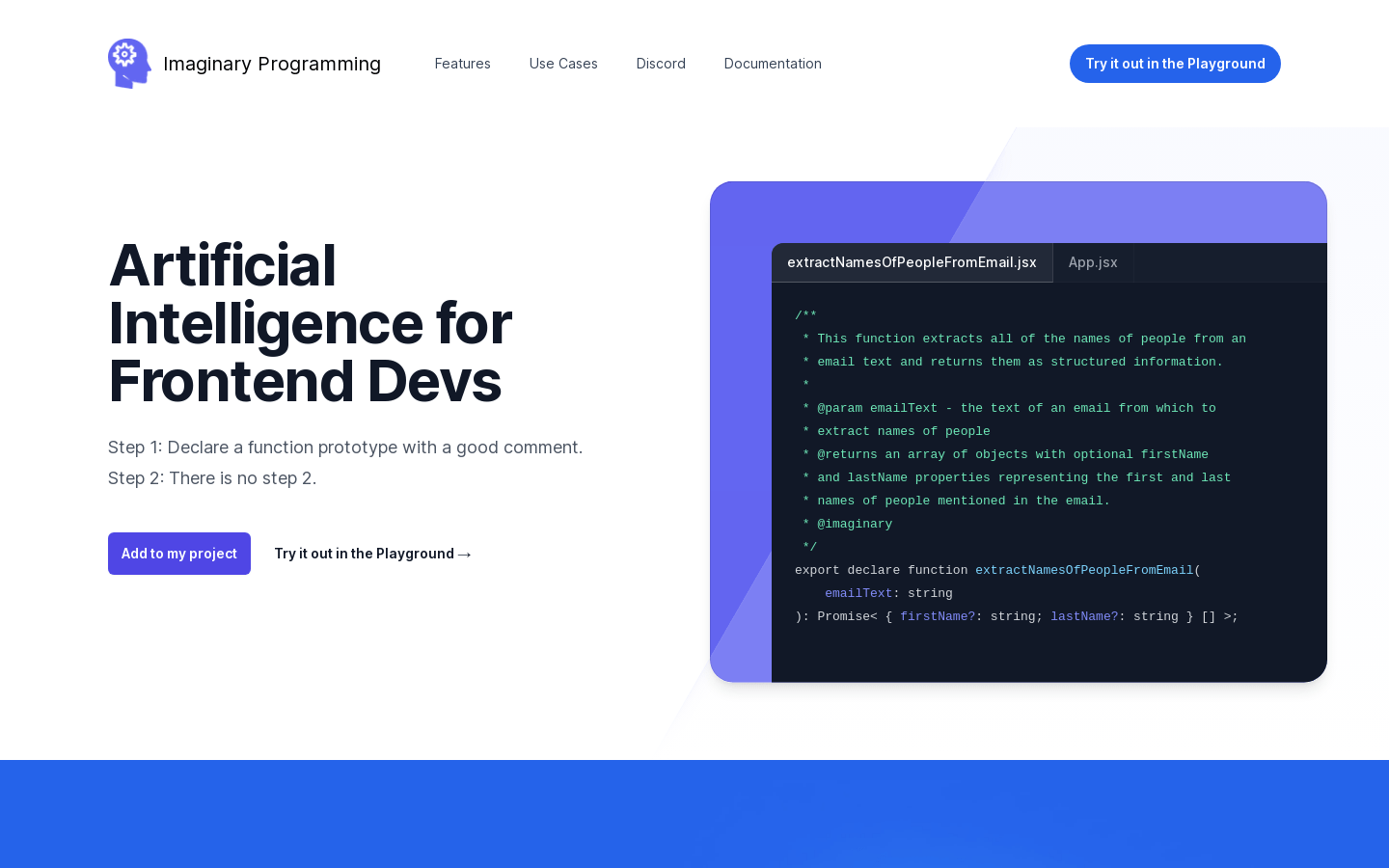










Imaginary Programming
Imaginary Programming:Prog. Imagination - Fast Think
Tags:Code assistantArtificial Intelligence Code assistant Development and Tools Development tools Paid Standard Picks Text Processing TypeScriptIntroduction to Imaginary Programming
Imaginary Programming is a cutting-edge tool that harnesses the capabilities of large language models to simplify application and website development. By integrating AI-powered intelligence into your workflow, this innovative solution streamlines the development process and enhances productivity.
How It Works
At its core, Imaginary Programming operates on a simple yet powerful principle: define your function prototypes in TypeScript without implementing the actual logic. The tool then leverages the GPT engine to automatically generate the required code, completing the implementation seamlessly. This approach reduces development time and allows you to focus on high-level design while letting AI handle the intricate details.
Target Audience
Imaginary Programming is designed for a wide range of users:
- – Developers seeking rapid prototyping and efficient code generation
- – Non-technical users looking to integrate AI-driven solutions without deep coding knowledge
- – Teams aiming to accelerate development cycles while maintaining high-quality output
Use Cases
Imaginary Programming excels in scenarios where text-based AI intelligence is required. Some common applications include:
- Generating compelling titles and descriptive text for marketing materials
- Data classification tasks to organize information efficiently
- Extracting structured data from unstructured sources for analysis
- Automating repetitive coding tasks through intelligent prompting
Key Features
Imaginary Programming offers a robust set of features that make AI integration seamless and effective:
1. GPT Engine as Runtime Environment
Leverage the industry-leading GPT engine to power your applications, ensuring access to state-of-the-art language processing capabilities.
2. Incremental Intelligence Addition
Easily add intelligent features to your projects without overhauling existing systems. Integrate AI-driven functionality step by step for gradual enhancement.
3. User-Friendly Integration
Designed with ease of use in mind, Imaginary Programming allows developers and non-developers alike to incorporate AI into their workflows effortlessly.
4. Structured Data Extraction
Effortlessly extract and organize structured data from GPT outputs, making it ideal for analytics, reporting, and further processing tasks.
Why Choose Imaginary Programming?
Imaginary Programming stands out in the AI development space due to its combination of simplicity and power. Whether you’re a seasoned developer or a non-technical user, this tool provides the perfect balance between ease of use and advanced functionality.
1. Accelerated Development Cycles
Automate repetitive tasks and focus on strategic initiatives by letting AI handle routine coding chores.
2. Scalable Solutions
From small-scale projects to enterprise-level applications, Imaginary Programming adapts to your needs, ensuring scalability across all stages of development.
3. Enhanced Productivity
By streamlining the development process, this tool allows teams to achieve more in less time, while maintaining high-quality output.
Getting Started with Imaginary Programming
Integrating Imaginary Programming into your projects is straightforward. Simply define your function prototypes in TypeScript and let the GPT engine handle the implementation. This approach not only saves time but also opens up new possibilities for innovation.
Example Workflow:
- Define Function Prototype: Specify your desired functionality using TypeScript syntax (e.g., `function greetUser(name: string): string;`).
- AI Implementation: Imaginary Programming’s GPT engine generates the complete function body based on your prototype.
- Testing and Deployment: Review and test the generated code, then deploy it into your application.
With its innovative approach and powerful features, Imaginary Programming is revolutionizing how applications and websites are built. Embrace the future of development today!
























